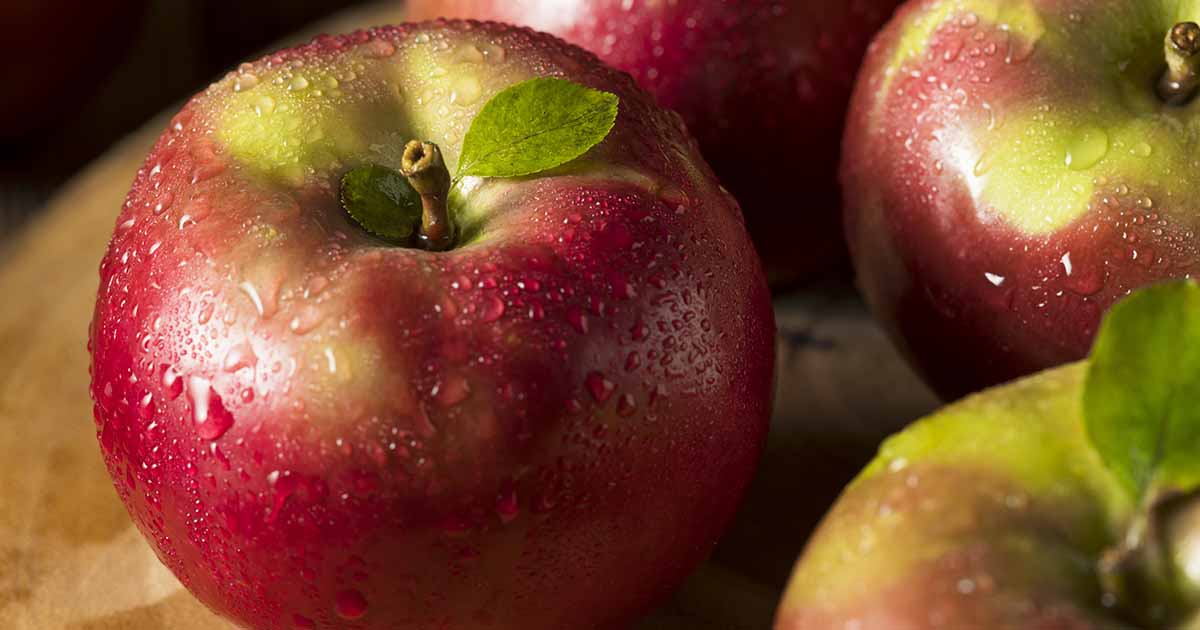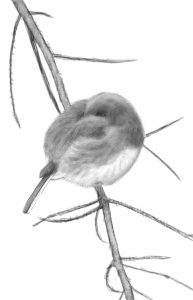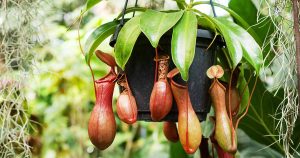
Malus x domestica ‘McIntosh’
Some apple cultivars are popular for a while and then seem to fade into insignificance, but others stand the test of time, dominating the commercial market year after year.
‘McIntosh’ is one of those perennial classics.
It’s Canada’s national apple, and it’s the one that the wildly popular computer was named for. How’s that for credibility?

We link to vendors to help you find relevant products. If you buy from one of our links, we may earn a commission.
Resistant to cedar apple rust and powdery mildew, ‘McIntosh’ apples dodge common problems while growing piles and piles of classic red fruits.
If you have dreams of growing your own ‘McIntosh’ in your garden, I totally get it. This is one of my favorite apples and when the fruits start to ripen in my garden, I feel like throwing a party.
To help you care for yours, we’re going to go over the following:
Cultivation and History
The good old “Mac,” as it’s commonly known, has quite the reputation.
It’s the national apple of Canada, appearing on the Canadian silver dollar, and is one of the classic New England orchard apples.

And, yes, the popular personal computer is named after this fruit. Developer Jef Raskin chose the name after his favorite fruit, but slightly changed the spelling to “Macintosh” to avoid lawsuits.
It’s hugely popular as a parent for breeding new cultivars.
But let’s go back to its origin story. Gather ‘round, children, while I tell you about the history of ‘McIntosh.’
Apples reached Canada in the early 1600s and growers started breeding them, working to create cultivars that would thrive in the local climate.
A farmer called John McIntosh left his home in upstate New York and settled with his wife Hannah on a plot of land in eastern Ontario in a township called Matilda, in the early 1800s.
In 1811, while he was working his land, he came across some seedlings that must have seeded themselves presumably from the imported European apples growing there.
He moved a particularly promising one next to his house and the fruit became a favorite of the family. They also sold the fruits locally and grew new specimens from seed, but none of the new trees had the stellar characteristics of the original.
John’s son Allan learned about grafting from an itinerant farmhand and started to propagate more of what they called “granny’s apple.” He started selling the trees in 1835.
The vigorous plant grows extremely well in cold climates, producing reliably as far north as USDA Hardiness Zone 4.
In fact, the fruit takes on the best color when it is exposed to cold weather in the fall as it ripens.

In the right conditions, the medium-sized fruits have thick, dark red skin wrapped around white or pale green flesh.
The flesh is crisp and juicy, with a mild, spiced, and honey-sweet flavor with just a hint of acid. Apple lovers say it has a wine-like flavor, which is one of the reasons why this tree is so popular as a parent for breeding hybrid cultivars.
The trees were sold under the name ‘McIntosh Red’ and available commercially by 1870.
By the mid-1900s, ‘McIntosh’ was one of the most popular apple cultivars in the US and the most popular in Canada. On top of that, dozens of hybrids had already been bred using ‘McIntosh’ as a parent.
Imports like ‘Gala’ slowly started to take over in commercial orchards. While ‘McIntosh’ still remains popular, it isn’t as common as it once was.
‘McIntosh’ Apple Propagation
You can’t grow ‘McIntosh’ from seed. You’ll need to purchase yours from a nursery or graft one from an existing tree that you have access to.
Grafting is a bit of advanced gardening, but it can be extremely rewarding. Essentially, you’ll purchase or grow a rootstock and then purchase or obtain the ‘McIntosh’ scion.
You’ll splice these together and seal them and let the tree grow as you would a purchased sapling.
You can learn more about this process in our guide to propagating apples.
If you purchase a bare root or potted plant from the nursery, dig a hole big enough to accommodate the roots.
Remove the plant from its container, if applicable, and put it in the hole so that the graft joint sits about an inch above the soil. Firm the soil up around it and water well. Add more soil if it settles after watering.
Space your specimens five feet apart.
How to Grow ‘McIntosh’ Apples
‘McIntosh’ does well in cold climates, but it’s not the right cultivar for warmer areas.
Don’t try to grow this cultivar further south than Zone 7 unless your region has mild summers and winters with about 800 to 900 chill hours.
If you aren’t familiar with chill hours, that’s just the number of hours below 45°F. Apples and many other fruit trees require a long period of cold to set fruit.

For pollination purposes you’ll also need another apple tree that flowers at the same time of year to ensure that your specimen will develop fruits.
‘Anna,’ ‘Cox’s Orange Pippin,’ ‘Cripp’s Pink,’ ‘Fuji,’ ‘Granny Smith,’ ‘Idared,’ ‘Jonathan,’ ‘Novaspy,’ ‘SunCrisp,’ ‘William’s Pride,’ and ‘WineCrisp’ are all good companions.
If you don’t have room for two trees, you might want to consider a different option. Of course, if your close neighbor has the right kind of tree, you can rely on theirs for pollination.
Learn more about apple pollination in our guide.
When it comes to watering, your tree’s needs will vary based on your local conditions, including how well the soil drains, relative humidity, the time of year and the weather, and the amount of rainfall.
On top of that, established specimens with healthy root systems are able to withstand more drought than a young or stressed tree.
It’s generally recommended to provide an inch of water per week, but just use that as a starting point and take your cues from your tree.
If you water and the soil is immediately dry several inches down, you should probably water more. If you water and the soil stays moist for days, you can probably water less often.
Read more about watering apples in our guide.
Make sure your trees receive full sun, at least six hours per day, but more is better. If half of your tree grows smaller or has thinner foliage, watch the sun throughout the day one day to see if part of the tree is shaded.
The soil should have a pH around 5.8 to 6.5. The reason this is important is because the wrong pH will restrict the amount of nutrients that the plant can absorb from the soil.
Test your soil every few years to ensure that the pH is in the right range. If it isn’t, amend the soil. Lime or wood ash can raise the pH.
Speaking of soil testing, do a test before you begin your fertilizer routine.
Your soil might have an abundance of certain nutrients and be deficient in others, meaning you’ll need to tailor your fertilizer for your particular soil.
You can send a sample of your soil to your local University extension office or buy a soil testing kit online. I’ve had good experiences with the MySoil test kit.
They give you a full analysis and advice on how to feed your soil. Buy yours at Amazon.
Typically, you will feed twice a year, once after flowering and once when the fruits are about the size of a marble. Wait until the tree is a few years old and is producing full-sized crops before you start feeding.
Apply the fertilizer starting at a few inches away from the trunk and out to the drip line of the tree.
Assuming you have fairly average soil, just pick up any fruit specific fertilizer like the Fruit Tree fertilizer from Down to Earth.
It’s formulated with feather meal, fish bone meal, langbeinite, alfalfa meal, and kelp meal to feed fruit trees with the nutrients they need to produce abundantly.
Down to Earth Fruit Tree Fertilizer
Pick up five, 15, or 25 pounds at Arbico Organics.
If you need more in-depth information about growing apples, check out our guide.
Growing Tips
- Grow in full sun in an area with 800-900 chill hours.
- Trees require about an inch of water per week.
- Feed twice a year, once after flowering and once when fruits are marble-sized.
Pruning and Maintenance
‘McIntosh’ tends to bear heavily one year and lightly the next. If you want to avoid this, be sure to thin the fruits in the spring.

Essentially, you’ll head out into the garden when the fruits are under the diameter of a quarter and you’ll remove some of them.
You also need to prune your tree regularly to ensure it produces well and to maintain its health.
Most of the pruning should be done when the tree is dormant. Many people opt for winter or early spring. That’s when you’ll give the tree some shape and ensure a good ratio of young and old wood.
You can remove dead, diseased, or deformed wood anytime of year. You can also remove water sprouts anytime, but during the dormant season is best.
Learn more about the pruning process in our comprehensive guide.
‘McIntosh’ specimens don’t need any special protection in the winter. They’re made for cold climates.
Where to Buy ‘McIntosh’ Apple Trees
The standard ‘McIntosh’ grows to about 15 feet tall. You can also find dwarf types.
For a standard tree in a variety of sizes, visit Fast Growing Trees.
Managing Pests and Disease
Apple trees have a reputation for being susceptible to many pests and diseases and I’m here to tell you that the reputation is… true.
Deer will browse on the lower leaves and stems and they will devour all the fruit they can reach.
And then there are the various diseases and pests. Let’s look at the creepy crawlies that might devour your plant, first.
Insects
When it comes to insects, all the usual suspects apply. Aphids, apple maggots, various borers, codling moth larvae, fruitworms, various mites, scale, and thrips are all common.
In my region of the Pacific Northwest, codling moths are a constant problem, while warmer areas are usually more troubled by apple maggots.
It’s worth reaching out to your local extension office to find out what the most frequent pest problems are in your particular neck of the woods.
Disease
‘McIntosh’ is one of the cultivars that is highly susceptible to apple scab and moderately susceptible to fireblight.
Both are common and extremely damaging diseases, so if these two are a frequent problem in your area, keep that in mind.

Read more about scab in our guide and all about fireblight in apples, pears, and plums in our article.
On the bright side, ‘McIntosh’ is resistant to cedar apple rust and moderately resistant to powdery mildew.
Learn more about common apple tree diseases and how to manage them in our guide.
Harvesting
One of the great things about ‘McIntosh’ is that the trees can start bearing fruit the year after you plant them. Of course, it won’t be a huge crop, but you’ll have some to harvest!

When mature, the fruits are about two to three inches in diameter. The apples that come off the tree earlier in the year tend to taste a bit more acidic.
As they age on the tree, they take on a sweeter, more mellow flavor, a bit like a glass of cider.
Expect them to start maturing around late September through mid-October, depending on where you live.
If you’d like a more thorough rundown about how to harvest apples, we have a guide that will walk you through it.
Preserving
‘McIntosh’ fruits hold their shape and texture well in storage but the flavor fades quickly.
That’s not necessarily a bad thing, it just means that they won’t taste quite the same as when they are eaten fresh.

They’re also easily bruised, so store them carefully and don’t move them around unnecessarily. Though the fruit has thick skin, it’s relatively soft.
Store them in the crisper drawer of your refrigerator so the flesh doesn’t become mealy.
They can last two or three weeks this way without degrading at all, and for up to three months, though they might lose some texture.
Otherwise, store your harvest in a cellar or other cool spot for up to three months. Find out more about storing apples in our guide.
Of course, ‘McIntosh’ apples can be processed into applesauce or butter and they work nicely for these purposes, as the flesh breaks down easily.
I also find them to be one of the best types for slicing up and dehydrating.
Recipes and Cooking Ideas
Part of the reason that ‘McIntosh’ fell in popularity is that the fruits aren’t very crisp, and modern consumers want a crispy, crunchy apple.
Plus, they have a thick skin, which some people don’t like, though this contributes to making them easy to grow in northern climates.

They have a citrusy sweet flavor, but they are much less sweet than many modern cultivars.
I personally like that, especially for cooking savory dishes. But for a sugary-sweet apple, this isn’t the best choice. To increase the sweetness, let the fruits fully ripen on the branch.
You can, of course, devour them straight off the tree, and since the fruits aren’t huge, they make the perfect snack-sized option.
Or slice them onto your charcuterie board with cheddar, since the flavor works well with meats and cheeses.
The flesh isn’t extremely dense, so they aren’t ideal for pies and tarts since the flesh tends to break down quickly when cooked.
You could mix them with something a little more firm like a ‘Granny Smith’ or ‘Honeycrisp’ for a bit more texture.
Quick Reference Growing Guide
| Plant Type: | Deciduous fruit tree | Flower/Foliage Color: | White, pink/green |
| Native to: | Central Asia | Maintenance: | Moderate |
| Hardiness (USDA Zones): | 4-7 | Tolerance: | Freezing temperatures |
| Bloom Time/Season: | Spring (flowers), late summer/fall (fruit) | Soil Type: | Loose, loamy |
| Exposure: | Full sun | Soil pH: | 5.8-6.5 |
| Time to Maturity: | 10 years | Soil Drainage: | Well-draining |
| Spacing: | 5 feet | Companion Planting: | Bleeding hearts, crabapples, crocus, daffodils, flowering quince, forsythia, Japanese camellias, pansies, tulips, wood poppies |
| Planting Depth: | Graft joint one inch above soil surface, same depth as growing container | Avoid Planting With: | Aggressive vines like English ivy and vinca |
| Height: | 15 feet | Family: | Rosaceae |
| Spread: | 10 feet | Genus: | Malus |
| Water Needs: | Moderate | Species: | x domestica |
| Common Pests and Disease: | Aphids, apple maggots, blister mites, borers, codling moths, fruitworms, leafhoppers, scale, spider mites, tent caterpillars, and thrips; Armillaria, black rot and frogeye leaf spot, bot rot, crown gall, gummosis, powdery mildew, sooty blotch and flyspeck, southern blight | Cultivar: | McIntosh |
The Apple of My Eye
‘McIntosh’ has been wildly popular for good reason, though it’s not everyone’s cup of tea.
It’s the perfect apple for making sauce and cooking, or for those who want one that will thrive in a cold climate.

Are you growing ‘McIntosh,’ and do you have any favorite recipes to share? Let me know in the comments section below!
And for more information about growing apple trees, check out these guides next:








